ROAD TEST



All-electric BMW i5 Touring put through its paces
THE GREAT AIRPORT RIP-OFF THE GREAT AIRPORT RIP-OFF Industry anger over rising drop-off charges
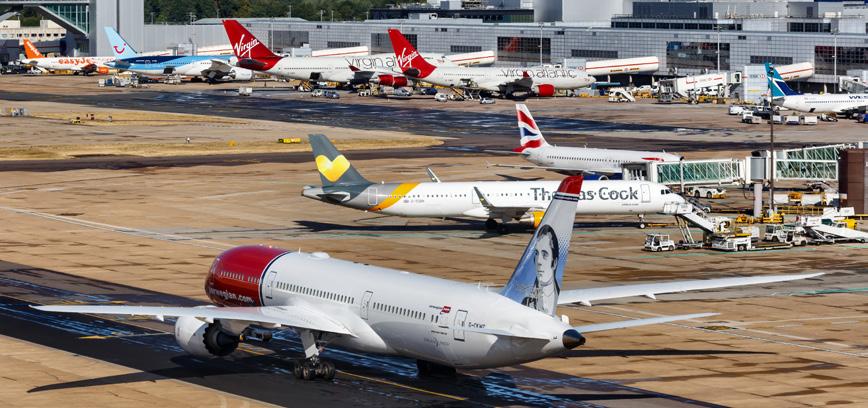































EDITORIAL DIRECTOR
Mark Bursa
07813 320044
markbursa@prodrivermags.com
COMMERCIAL DIRECTOR
Paul Webb 07807 133527
paulwebb@prodrivermags.com
CONTRIBUTORS
Gary Jacobs, Kevin Willis, Tim Barnes-Clay, Phil Rule, Kwabena Dennot Nyack, Dr Mike Galvin, Tim Scrafton
COMPANY ADDRESS
50 Beechcroft Manor, Oatlands, Weybridge, KT13 9NZ
WEBSITE
Martin Coombes
PageHub Design
martin@pagehubdesign.co.uk
SUBSCRIPTIONS
Curwood CMS Ltd, The Barn, Abbey Mews, Robertsbridge, TN32 5AD 01580 883844
subs@prodrivermags.com
Registered in England No. 7086172
© 2025 All contents copyright of ProDriver Media Ltd
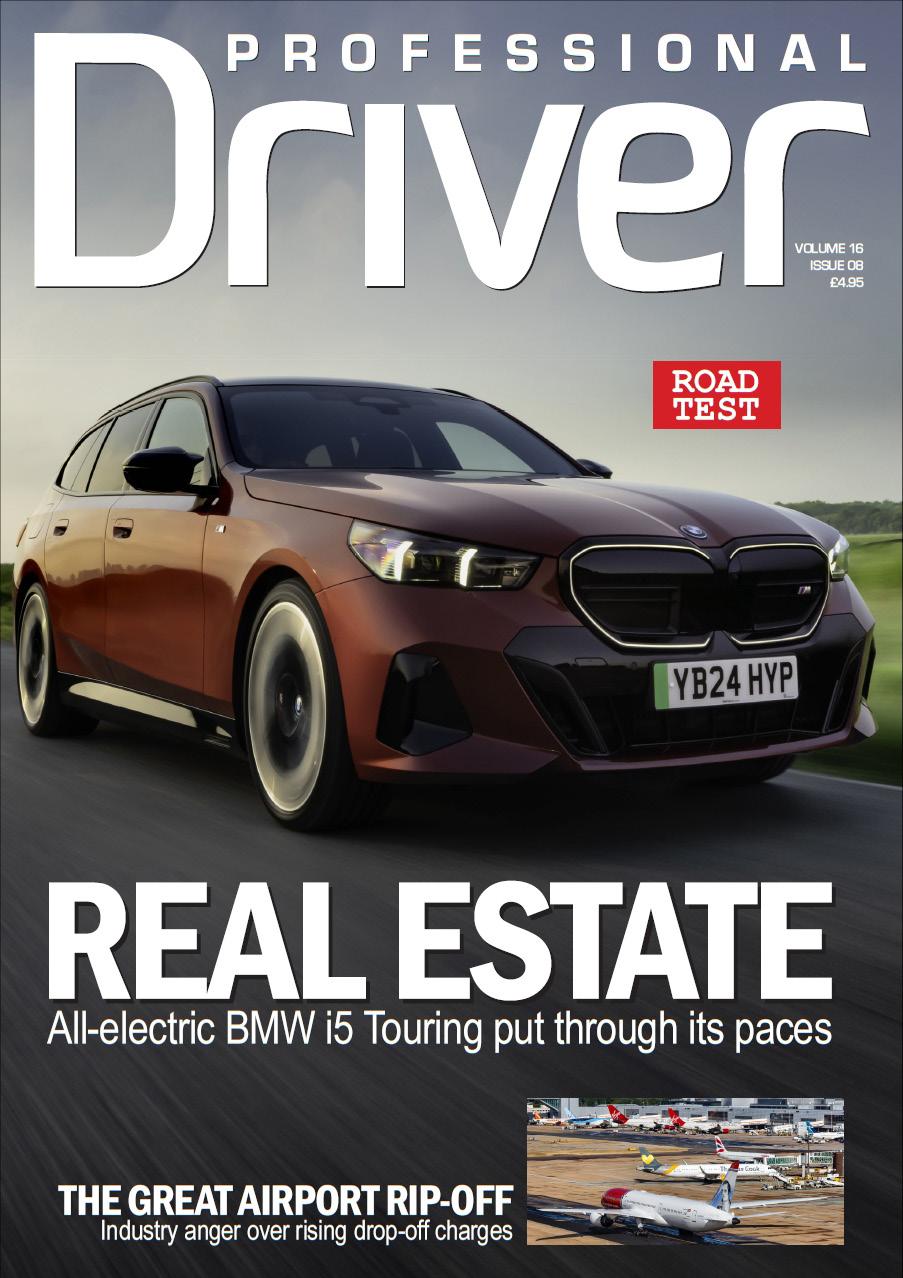

“ Mark Bursa
Who’s there to help if something goes wrong – or worse, if someone tries to hijack the autonomous car? ”
OK, answer me honestly. Does anyone in this industry actually want autonomous taxis? Uber, naturally, wants to be the first to market with self-driving technology. It’s been piloting the technology with some degree of success in America, where wide, straight roads and large amounts of urban sprawl does make the technology easier to install.
But in the UK, the more you look, the greater the depth of the problems. Our roads are twisty, narrow, and very crowded. There are multiple users – cars, delivery vans, other taxis, cyclists, pedestrians and just about anything else you can think of.
I’ve driven high-spec cars from the likes of Mercedes, BMW and Audi on UK roads, and I’m pretty sure I’d trust my own judgement over the algorithm. OK, the tech makes sense in a motorway traffic jam, where the AV can inch along behind the slow-moving car in front. But who’d choose to be in a “robotaxi” late at night, travelling through city suburbs to a home some way away?
Who’s there to help if something goes wrong – or worse, if someone tries to hijack the car? And AVs are pretty easy to hijack. Just stand in front of them and they’re programmed to stop.
Now a trained driver could get you out of trouble. But what do you do in the AV? Call the Uber helpline? “Thank you for your call. All our operators are busy right now. You’re held in a queue and your place is number 67…”
The previous Conservative government passed an autonomous vehicles bill before they were rightfully dumped out of office. Even the minister in charge of the bill lost his seat in 2024. Clearly this is lower on the agenda for Labour – they have plenty of more pressing things to fix – and the AV bill has been kicked down the road already until 2027.
The Tories cited “road safety” as a reason for implementing the bill. And it’s true that if all the cars were AVs, human error would be eliminated.
But that’s clearly not going to happen in any of our lifetimes, and the risks of accidents are likely to increase with the current standard of robo-cars sharing the road with everyone else.
More importantly, what happens to the hundreds of thousands of people who earn
a living through driving? There are nearly 400,000 registered taxi and private hire drivers in the UK alone. Add in delivery drivers and that more than doubles. That’s close to a million people out of work, because Uber and co want to “maximise shareholder value”.
Uber talks of reassigning drivers to other jobs in the organisation, such as software development. Yeah, right. There’s a reason a lot of people are professional drivers. They don’t want routine office jobs, or they don’t possess the higher education skills needed to do such jobs. Driving is a hugely satisfying and rewarding career for a lot of people – or it would be if the people who want to replace them actually paid them properly.
In reality, those “other, no-driving jobs” will probably involve a mop and bucket. Those drivers will be reassigned to cleaning out vomit or worse from the back of the unsupervised robotaxi, as well as binning half-eaten Doner Kebabs and KFC bones.
Others may be assigned to the depot to fix vandalism and damage caused to the vehicles by less savoury “customers” or others. Scraping off graffiti is likely to be a big part of the job.
Because no matter how clever your algorithm, it can’t factor in some of the less desirable human traits.
OK, we can’t “uninvent” things. And driver assistance systems are clearly a positive development – automatic city braking, adaptive cruise control, LiDAR and other innovations help us to drive more safely.
But they can’t replace the driver. How does the autonomous car help the passenger with heavy luggage? How does it fit child safety seats? How does it spot that the passenger in the back is not well, or worse, is contemplating self-harm?
A good driver does just that – we’ve rewarded several excellent drivers at the Professional Driver QSi Awards whose prompt actions have saved lives.
If Uber wants to go down the AV route, let it. We don’t have to keep on joining its race to the bottom. Celebrate the skills and qualities of the driver, and turn autonomous taxis into an irrelevant distraction. A technological blind alley, like fax machines and VHS videos.
When someone asks the question as to who wants autonomous taxis, let the answer be “nobody”.
Mark Bursa
HMRC has stopped requiring Uber to collect full VAT on its ride-hailing platform after rival Bolt won its VAT case in the Upper Tribunal last month.
The court ruled that Bolt was not acting as “principal” in supplying transport from self-employed drivers, and therefore its fares should only qualify for VAT on the margin Bolt charges under the Tour Operators’ Margin Scheme (TOMS), which is used widely throughout the sector.
The tribunal ruled that Bolt’s drivers remain independent contractors rather than employees or ‘workers’, so Bolt was not the principal in the transaction and therefore not responsible for full VAT. The upshot is lower fares for Bolt customers – and potentially far less VAT revenue for HMRC.

The Bolt ruling means HMRC has dropped its insistence that Uber keep paying VAT on the full cost of fares, instead of just on the company’s margin, and will do so until the matter is fully resolved in court, according to Uber’s quarterly financial statements.
HMRC has demanded Uber pay VAT on whole fares since 2022 when the company was forced by a UK Supreme Court ruling to start treating drivers as ‘workers’. Every quarter,
after Uber pays the lower amount it says it owes, HMRC sends an “assessment” of more than £100m to cover the difference.
Uber has until now needed to pay the assessments “in order to proceed with the appeal process”, according to successive quarterly filings. The disputed amount it has paid now totals £1.4 billion. “The payments do not represent our acceptance of the assessments,” Uber has said.
“HMRC has expressed
their intention to not enforce assessments pending the determination of the appeal of a competitor on a related matter,” Uber said.
Uber is fighting the verdict in the so-called “Sefton” case, where two large private hire operators, Veezu and Delta Taxis, have so far successfully persuaded the courts that they are not the “principal” and therefore should only pay VAT on the TOMS scheme, not in full. Uber's appeal will go to the Supreme Court for a final ruling in July.
The Government is also analysing the results of a public consultation on the subject of VAT on private hire fares, but is unlikely to make a final announcement until after the Sefton case is resolved. Uber generated £5.3bn in revenue in the UK in 2023, 18% of its worldwide revenue.
Mark Bursa
Bolt has appointed a new UK boss, with a brief to grow what has become the ride-hailing operator’s second-biggest market.
Kimberly Hurd (pictured) will join as the company’s senior general manager for the UK, following stints in the fintech sector and at Indian food delivery app Zomato. “I’m here to grow the market,” she told London media. “My role is to focus on execution, market share and growth.”

Hurd added: “Seventy percent of users don’t own a car in the UK, so really the future of public transport more generally is a mesh between public transport and ride-sharing. So we see the bigger vision of transforming how cities function.”
She joins the company as it gains the upper hand in a long-running dispute
surrounding VAT charges on fares, where a Tribunal has ruled that Bolt does not act as the principal in transactions with customers, and therefore only has to pay VAT on its margin, not the whole fare.
This ruling could be challenged later in the year if a Supreme Court judgement against rival Uber on a similar case,
expected this summer, yields a conflicting result.
Earlier this year, Bolt wrote to Chancellor Rachel Reeves, stating it had withheld £200m of investment in the UK over the past three years as ministers decide whether or not to charge 20% VAT on fares. A consultation on the matter closed earlier in the year, but no ruling is expected until after the Uber case is resolved.
Hurd said more clarity was needed from government over VAT. “Bolt, like every other player, is just looking for some degree of transparency and certainty around the topic,” she said. Last November Bolt lost a legal challenge against a court ruling that classed its drivers as “workers”, which could land the company with a bill of up to £200m in unpaid sick pay, holiday pay and other employee benefits.
Mazda is returning to the medium saloon sector with an all-new electric version of the Mazda6. The Mazda6e is offered with two powertrain options and a choice of 68.8kWh or 80kWh battery.
The five-door hatchback will arrive in the UK in the first half of 2026, and UK pricing and full specifications will be revealed later. The previous petrol and diesel Mazda6 model was withdrawn in 2023.
Customers can choose between two electric powertrains delivering 258PS or 245PS - both configurations deliver 320Nm of torque, ensuring smooth acceleration and responsive rear-wheel drive performance.
Like all Mazda models for the European market, the all-new Mazda6e has

been jointly developed by engineers in Hiroshima, Japan, and Oberursel, Germany, to meet the expectations of European customers.
The Mazda6e has rear-wheel drive, a multi-link rear suspension, and a
balanced 50:50 weight distribution. There are three drive modes: Normal, Sport and Individual, allowing drivers to tailor acceleration, steering resistance and regenerative braking to their tastes.
Mark Bursa
The GMB Union has called for a London-wide cap on private hire driver numbers as part of a stinging attack on Transport for London’s Taxi and Private Hire Action Plan.
At a meeting at City Hall (pictured) the union slammed TfL for not putting industry sustainability at the heart of their scheme.
The GMB is the UK’s largest private hire union, and it is calling for measures that enhance driver earnings and safety, ensuring that the wider transport network is environmentally and economically sustainable.
Among the specific measures the union is asking for is a limit on private hire vehicles to reverse a decline in drivers’ earnings. In 2024, 55% of members using driving apps claimed that their earnings were

significantly lower than 2023 levels, and more than 80% claimed that their earnings were either the same or slightly lower than the previous year.
GMB called for a debate on measures that can address market saturation, providing fair protection for London-licensed drivers. Mayors in Manchester and North Yorkshire have already started similar debates, and GMB believes TfL risks getting left behind.
Steve Garelick, GMB
regional organiser, said:
“Further saturation of the private hire market is unsustainable; it will continue to have a negative impact on drivers and competition. GMB is calling on TfL to deliver a more sustainable industry for both drivers and operators – one where drivers are not forced to work longer hours just to earn a liveable income, and where their safety is not put at risk in the process.”
With oversaturation of the market and increasing costs, some drivers reportedly
work 16-hour days to break even. Representatives said this is having serious effects on both road safety and driver well-being.
Alex Marshall of the IWGB union joined in the debate, claiming conditions were “unsustainable”, with fatigue and stress common across the sector. Many drivers now see no viable route to financial stability in the job, he said.
The unions also criticized TfL’s new licensing system, which has caused long delays in processing driver license renewals and new applications, which has left many drivers unable to work for weeks or even months.
GMB’s Garelick said TfL’s new licensing platform was not properly tested before being rolled out, describing it as a “system failure” that shifts basic administrative burdens onto worker organisations.
Mark Bursa
US-owned ride-hailing service Lyft has made a long-awaited entry into European taxi markets with the acquisition of FreeNow.
Lyft, which is Uber’s main rival in North America, has paid €175 million (£150m) to buy the European taxi app from the partner companies that set it up, BMW Group and Mercedes-Benz Mobility.
The deal gives Lyft access to nine European countries and more than 150 cities. Lyft currently only operates in the US and Canada. FreeNow partners with taxi and private hire operators in the UK, Ireland, Germany, Greece, Spain, Italy, Poland, France, and Austria. The transaction is expected to be finalised in the second half of 2025.
In a statement, Lyft said FreeNow would “continue operating as it does today, with its talented leadership team and employees in place Lyft found
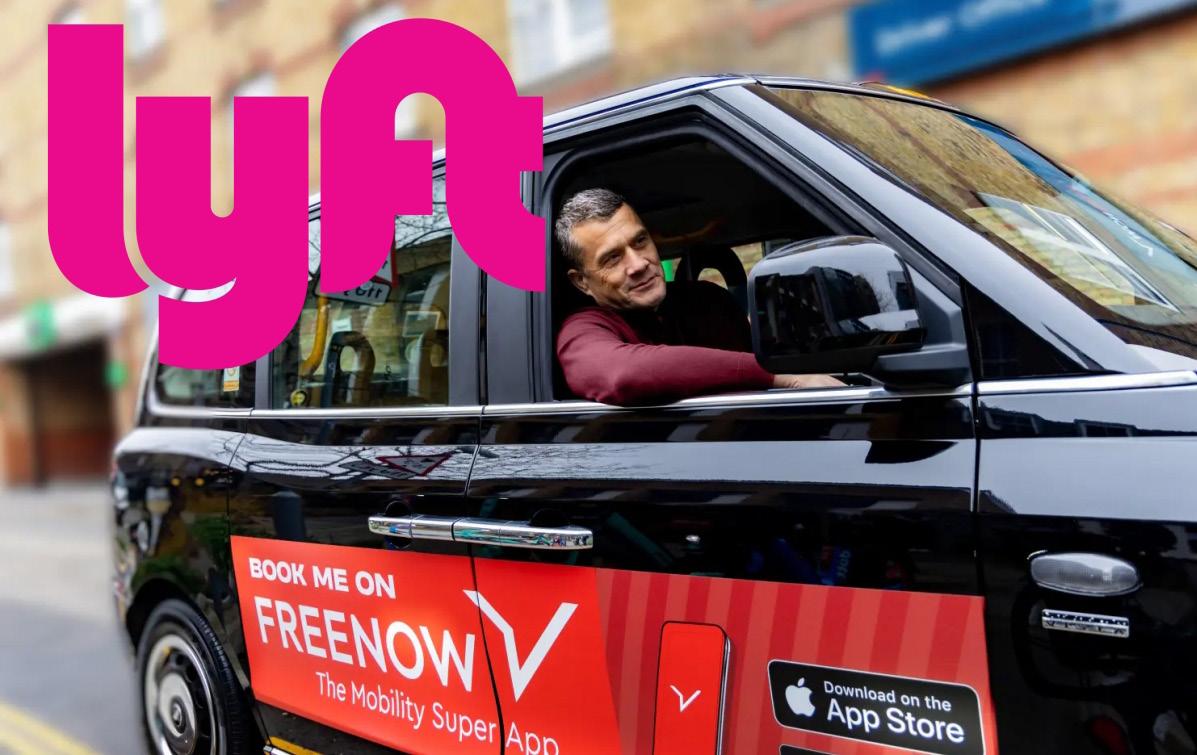
in FreeNow a partner to immediately fuel its growth strategy, unlock potential for partners, and level up the experience for drivers and riders alike”.
The deal nearly doubles the size of Lyft in terms of annual journeys to more than 300 billion personal vehicle trips per year. It increases annual gross bookings by approximately €1bn and diversifies revenue streams.
“We’re on an ambitious path to build the best, most customer-obsessed mobility platform in the world, and entering Europe is
an important step in our growth journey,” said Lyft CEO David Risher. “We found the perfect partner in FreeNow and can learn a lot from the team.”
FreeNow brings market-leading European taxi expertise, fleet technology and strong relationships with regulators, unions and taxi fleet operators.
“The business models are complementary and together will serve over 50 million combined annual riders, with plans to deliver a better product experience, improve service levels, strengthen fleet manage-
ment capabilities, and bring greater global opportunities to existing and potential partners.”
In Europe, the taxi aggregation business is growing. Approximately 50% of taxi bookings in Europe still happen offline, but customers are moving toward online bookings. FreeNow is the leading taxi platform in several major European cities, including Dublin, London, Athens, Berlin, Barcelona, Madrid, and Hamburg, with luxury vehicles making up a significant portion of its fleet. Taxis accounted for approximately 90% of FreeNow’s gross bookings in 2024 and will continue to be the backbone of its business.
“Joining forces with Lyft is a powerful step forward for FreeNow and marks the beginning of an ambitious new phase—one where we strengthen our role as a leading force in European mobility,” said FreeNow CEO Thomas Zimmermann.
Just weeks after its acquisition by Lyft, FreeNow has launched its ride-hailing service in Glasgow. And rather than directly recruiting drivers like Uber, FreeNow has partnered with Glasgow operator Saltire Private Hire to provide its rides.
FreeNow users in Glasgow can now book rides through the FreeNow app, and that will direct the bookings to Saltire Private Hire.
Journeys can either be “hailed” immediately via the app, or pre-booked up to four days in advance. Payments can be made via Apple Pay, Google Pay, PayPal, debit card, or cash.

Glasgow is the second Scottish city after Edinburgh in which FreeNow operates, and the ride-hailer said it planned further expan-
sion into other UK cities. In London it mainly works with the black cab trade, though a private hire option is also available.
Saltire Private Hire operations manager Rob Finlayson said the move would
increase earning opportunities for drivers across Glasgow and the surrounding areas.
“This collaboration underscores our commitment to innovation and delivering exceptional passenger transport services in the region,” he said.
Danny O’Gorman, recently appointed as general manager of FreeNow UK, said: “Following the success of FreeNow in Edinburgh, with more than half a million taxi requests in the past three years and growing, we are pleased to announce that our app is now available to both residents and visitors in Glasgow, making it easier for people to book a ride whenever they need one.”
Leading Scottish chauffeur operator Little’s Chauffeur Drive has expanded into the Aberdeen market through the acquisition of Vigilant Chauffeur Services.
This strategic acquisition brings together two highly respected names in the industry. Little’s has supported clients in Aberdeen for nearly 60 years through its established operations in Glasgow and Edinburgh, but this move represents a significant local investment, including the introduction of a dedicated fleet of Little’s distinctive maroon-liveried cars in north-east Scotland.
Vigilant Chauffeur Services (Vchauffeur) has built a local strong reputation for service and expertise. To ensure a smooth transition and maintain the high standards both companies are renowned for, Little’s will work closely with Vchauffeur director Mark Cochrane over the next year. His in-depth knowledge of the local market and long-standing client relationships are expected to be instrumental in further developing Little’s presence in Aberdeen and the surrounding areas. With this
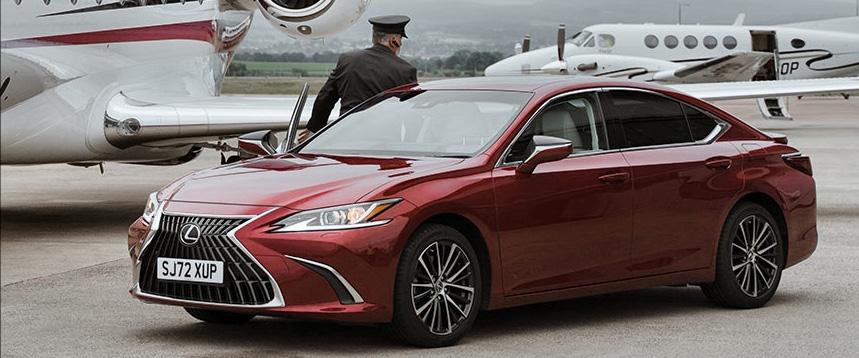
acquisition, Little’s will now offer its full suite of services directly from Aberdeen, and clients can expect 24/7 access to Little’s partners in 125 countries worldwide.
Heather Matthews, managing director of Little’s Chauffeur Drive, said: “This acquisition is a great step forward for both businesses, combining strengths to enhance our service in Aberdeen. As we near Little’s 60th anniversary, it reflects our continued growth as a proud
family business with a strong heritage and commitment to excellence.”
Vchauffeur Director Mark Cochrane said:
“After an exciting five-year journey building the Vchauffeur brand, our recent acquisition by Little’s made perfect sense. We share the same principles of exceptional service, discretion, and professionalism. I now look forward to working closely with Little’s to develop their presence in north-east Scotland.”
Mark Bursa
Veezu has wasted no time in rebranding its two recently-acquired Manchester fleets under the Veezu banner. Both Club Cars and Passenger Cars, bought in November 2024 and January 2025 respectively, are now carrying Veezu branding on their combined fleet of more than 500 cars.
The two acquisitions gave Veezu full coverage across most major conurbations in South Lancashire and West and South Yorkshire. Veezu has bought Britannia Cars in Liverpool, Amber Cars in Leeds and City Taxis in Sheffield. Last October it acquired the 1,000-car Drive group, which has operations in Hull, Doncaster and York.
Most of these have already been rebranded to Veezu as part of the Cardiff-based company’s plan to create a national private

hire brand. Veezu is now the UK’s largest private hire operator with 16,000 self-employed drivers signed up across many UK cities.
Club Cars was established in 1992 in Wythenshawe, and has depots in Wythenshawe, Chorlton, Didsbury, Levenshulme and Stretford as well as Manchester city centre. Passenger Cars was founded in 1998 and covers Trafford, south Manchester and east Cheshire. Veezu also owns operations in
Bolton and Wigan, giving it extended coverage of the Greater Manchester area.
Under the unified Veezu brand, passengers and driver-partners will benefit from enhanced technology, smarter ride features, and a substantial investment in greener vehicles, including the addition of new zero-emissions capable vehicles to the fleet as part of a total investment exceeding £1.5 million.
Veezu CEO Nathan
Bowles said: “Manchester’s Club Cars and Passenger Cars have built strong, trusted reputations by delivering exceptional local service. As we bring both brands together under the Veezu name, we’re not only introducing improved technology and a greener fleet – we’re strengthening our role as a key part of Greater Manchester’s transport network and are proud to support the region’s ambition for a more connected future.”
“Manchester is moving further and faster than any other region in the country when it comes to electrifying its transport networks, and we’re proud to be part of that journey. By continuing to invest in a greener fleet, we’re not only supporting the city’s bold sustainability goals, but also helping to improve air quality for everyone who lives and works here.”
Mark Bursa
A new booking platform designed to help local chauffeur and private hire operators eliminate empty mileage is being launched by a South coast chauffeur operator.
The Backruns platform, which goes live at the end of May, is the brainchild of Steve Hook and Jo Dakin, who run Bournemouth-based chauffeur firm Presla. The system is deigned to allow groups of local operators to share jobs, resulting in fewer miles driven and greater profitability.
Backruns has been designed to help independent chauffeurs, private hire drivers, and small operators to be as efficient as larger operators with bigger fleets.
Backruns allows collaboration between independent drivers in the same platform, while maintaining

their autonomy. This collaboration creates ‘circles’ of similar driver-operators whereby each circle can share their workload.
Diary functions within the system provide a booking system for each driver and a shared diary for the ‘circles’ of operators. This allows operators using Backruns to manage conflicting bookings and share workload opportunities between drivers in the circle. This increases the opportunities to fill empty legs – or “backruns”.
“Backruns allows us to
give a competitive edge to all independent and executive solo and small private hire driver operators across the country,” said Backruns chief executive officer Jo Dakin. “This is an effective booking tool plus gives the peer group or ‘circle’ the facility, through peer-to-peer collaboration, of organising trips more efficiently, the chance to double its fare-per-mile ratio, and halve its time on the road.”
Backruns chief technology officer Nick Cox said: “Our platform has been de-
signed, tailored and tested by long-distance independent chauffeurs.
Initial live testing has shown a 30% increase in fare income while driving the same number of miles. This was in a single week. The live ‘test circle’ had good collaboration and secure visibility while maintaining operator independence.”
The booking diary contains information about pick-up and drop-off locations, driver and vehicle assignment, client and driver payment processing, plus the ability to message between operators and drivers to automatically share work.
Backruns is a subscription-based month-onmonth service, and the company believes the subscription fee, which is yet to be announced, will be recouped quickly from the expected increase in profitable backrun gains.
Around 100 Derby private hire drivers joined a union rally outside Derby City Council this week, in the ongoing campaign against the authority’s plans to slash the licensable age of vehicles from 15 years old to just 5 for new license applications.
The drivers presented a petition to the council protesting the change, which came into force on April 1, 2025, and called on the Conservative chair of the city’s licensing committee, Cllr Alison Holmes, to reverse the decision.
GMB regional organiser Craig Thomson said: “This rally has sent a clear message that Derby’s private hire drivers will not be ignored. We all want a greener city, but these plans put all the burden on the working people of Derby. There is a real sense of outrage over this decision, which threatens putting drivers out of work.”
He continued: “The Conservative councillors in charge of the city’s licensing

committee are pushing policies designed to make Derby greener, but will only result in local people being poorer”.
The plans will threaten the licenses of hundreds of drivers using vehicles made before 2021. Derby’s plans will put Derby out of step with neighbouring citiess such as Nottingham, where the licensable age of PHVs is set at 10 years.
Thomson said: “Instead of working with drivers and their Union, the Tory opposition councillors pushing this change seem to be
taking a one-sided approach to reach the 2035 target.”
The union claims the expense of a vehicle less than five years old could reach around £15,000, potentially forcing drivers out of business or prompting them to seek licenses elsewhere. Derby City Council maintains the new age limit aims “to ensure vehicles are in good condition and more likely to meet current safety and emissions standards”, saying most drivers would not be affected.
Earlier Derby Council had to apologise to 158 drivers who had been misinformed about the change in the rule, and were told that a 15-year-old car was acceptable. At least two drivers purchased cars more than 5 years old. The city council said it would provide a vehicle license to the drivers “who have acted in good faith”.
Charging network Ionity is planning to roll out new “megawatt” chargers, capable of delivering a 200-mile recharge to compatible cars in around 8 minutes.
Ionity is becoming the first charge point operator to procure the latest HYC1000 chargers from Alpitronic, which can deliver power to a single vehicle at 600kW – almost twice the speed of the fastest chargers in use today.
The Alpitronic megawatt charging system has a central power cabinet that distributes power to up to four dispensers, each equipped with two charge points. This allows for the simultaneous charging of up to eight electric vehicles, with dynamic power allocation per charge point - or a single vehicle charging at up to 600 kW.

will evaluate how fast the chargers can operate. Ionity says its goal is to offer users even shorter charging times and maximum efficiency.
The Alpitronic HYC1000 chargers were launched in February. Ionity plans to roll out these chargers across its network in the second half of 2025, starting in May with a test site near Munich, where Ionity
“By integrating the HYC1000 chargers, we’re giving our customers access to some of the fastest and most advanced charging technology available today,” said Ionity CEO Jeroen van Tilburg.
“This integration marks another key milestone in our mission to deliver ultra-fast, convenient charging at scale for EV drivers across Europe.”
Ionity now has more than 700 charging sites and 4,800 charge points across 24 European countries, with all electricity sourced from 100% renewable sources.
Founded in 2017, Ionity is a joint venture between BMW Group, Ford, Hyundai, Kia, Mercedes-Benz, Volkswagen Group and BlackRock’s Climate Infrastructure Platform.
Chinese automaker BYD has also announced it was using its self-developed “megawatt” chargers in China and said it would make the technology available to European charge point operators as compatible cars become available.
Mark Bursa
In a major policy shift, Uber has introduced cash payments for customers in many of the the UK cities in which it operates – though not in London. Previously Uber operated solely via bookings made via credit card through its app. Now Uber appears to recognise that significant sector of the UK population still wants to use cash.
Uber wants to introduce cash payments in London too, but its proposals are under review by Transport for London pending a decision, so for now, Uber’s London ride-hailing service remains cashless.
The move follows an 18-month trial that revealed a persistent demand for cash, especially among

people without bank cards or those who simply prefer using money they can touch and track. Uber now lets users choose “cash” in the app as a payment option. If the driver doesn’t have enough change, Uber ensures the passenger receives a credit for the difference.
Uber said it would not force the new policy on
drivers. For many drivers, carrying money in the car adds a layer of risk of robbery, so drivers have been given the freedom to opt out of accepting cash altogether. Drivers can simply disable the feature in their app settings.
For now, the cash payment option is limited to ride-hailing services. It does
not apply to Uber Eats orders or other transport modes booked through the platform.
Uber’s decision arrives amid louder calls to protect access to cash in an increasingly digital economy.
The government’s Treasury Committee recently published a report warning that millions of people, including elderly individuals, those with disabilities, low-income families and victims of domestic abuse, could be left behind if cash disappeared altogether, though the committee did not go so far as to recommend a law mandating cash acceptance.
Bursa
Chauffeur service Blacklane has been granted a London private hire operator’s license by Transport for London.
The development will allow Blacklane’s dedicated London operations team to recruit more independent chauffeurs throughout the capital to respond to increased demand, with Blacklane significantly growing its portfolio of partners across London.
An enhanced programme of orientation days is now on offer to interested chauffeurs. Any professional chauffeur working with Blacklane is offered the opportunity to engage in additional qualifications to improve their service standards and boost revenue.
Alan Sceeny, Blacklane’s

head of London operations, said: “Ride growth across London for Blacklane in 2024 was significant, with high guest satisfaction and industry leading levels of EV penetration – more than 50% of Blacklane journeys
in London are now in an EV. We’re excited to build on this further in 2025 with an expanded network of chauffeur partners.”
Blacklane’s services in London include airport transfers, chauffeurs by-the-
hour, in-city rides for both pre-book and immediate departure, and city-to-city services offering longer rides connecting London with hubs such as Oxford, Cambridge, Birmingham and Manchester.
EV charging network Be.EV has signed a deal to install more than 200 ultra-rapid EV charging bays across 22 major retail and leisure centres in the UK.
The sites are all managed by Schroders Capital, and the £20 million investment will see Be.EV fully fund the installation and maintenance of charge points at retail and leisure parks, where retailers include Sainsburys, Aldi, Lidl, Costa Coffee, KFC, McDonalds, Nandos, Pizza Express, Starbucks, Marks & Spencer and IKEA. Be.EV will install ultra-rapid Kempower chargers capable of delivering charging at up to 300kW. These can add up to 325 miles of range in as little as 20 minutes on compatible EVs.
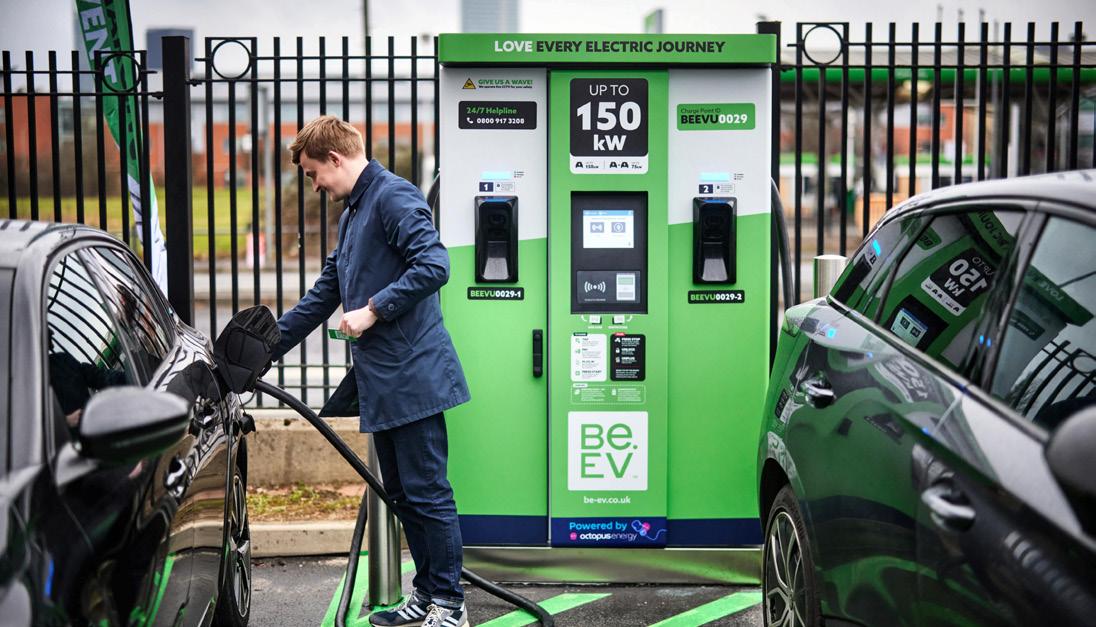
exchanged on the first three Schroders locations, with further exchanges expected imminently.
The charging hubs, most of which will feature six to 12 charging bays, will be leased on a 20-year agreement with index-linked market rents, reflecting the commitment from both Schroders Capital and Be.EV to sustainable infrastructure development. Legal agreements have been
Asif Ghafoor, CEO of Be.EV, said: “This is a landmark deal for Be.EV and we are excited to help the big brands who occupy the retail parks in Schroders portfolio benefit from the increased footfall benefits EV charging brings.”
Be.EV has also partnered with Maple Grove Developments to install 12 ultra-rapid charging bays at the new Hattersley Trade
Park in Greater Manchester. Be.EV will invest £892,000 to deliver the new charging hub, situated just off the A57, which is scheduled to open in June 2026 and will feature a Costa Coffee drive-thru and an Aldi supermarket.
And last year Be.EV announced a £4m scheme to build the Manchester Charging Oasis charging hub of the future in Failsworth.
A survey last year found 57% of drivers who use a public charger will go shopping or visit a cafe while charging their vehicle. These benefits to retailers are only going to grow, with registrations of new EVs expected to grow by 31% in 2025.
Be.EV currently operates a growing network of more than 800 live charging bays across the UK, a figure expected to reach 1,600 by the end of 2025. Be.EV is majority-owned by Octopus Energy Generation’s £1.5bn Sky Fund, which has pledged £110m of funding in EV charging infrastructure.
We’re proud to have great relationships with some exceptional partners. Did you know that as a client of the Howden Chauffeur team, you can now get up to 10% off at Charles Tyrwhitt?
So, if you’re not already insured with us, now might be a good time to get in touch. And if you are insured with us, contact your account handler to receive your discount code.
We pride ourselves on building relationships that go beyond policies. Get in touch today on 020 8633 8450 or email chauffeur@howdeninsurance.c

Uber says it wants to put autonomous taxis on UK roads by 2027 – providing the Government gives the green light to the scheme.
Andrew Macdonald, senior vice president of mobility at Uber, told the BBC: “We’re ready to launch robotaxis in the UK as soon as the regulatory environment is ready for us.”
The UK government had originally planned to approve autonomous vehicles for use on the roads by 2026, but has now pushed back the plan until 2027.
Uber already operates driverless taxis in the US, China, the UAE and Singapore. In those markets, Uber customers have the option of ordering an autonomous cab via the Uber app, so they only receive one if they specifically request one. The fares are not cheaper – an autonomous cab costs the same as one with a driver in these markets.
This means users who are

justifiably uncomfortable with the concept of driverless cars will not be forced to use one. UK online polling suggests there is overwhelming opposition to the concept on grounds of safety.
An Uber spokesperson said: “The UK is one of the most promising countries for AVs in the world where we will continue to work with partners towards the safe deployment and adoption of autonomous technology.”
The Automated Vehicles
Act became law on May 20, 2024, under the previous Tory Government. It was intended to be implemented in 2026, but the Labour government has pushed it back by 12 months. The Department of Transport has now said it will implement the legislation in the second half of 2027.
The transport secretary under the previous government, Mark Harper, who lost his seat at the 2024 election, had claimed that autonomous vehicles were “expected to improve road
safety by reducing human error, which contributes to 88% of road collisions”.
But the issue remains mired in legal issues, including who is responsible if a self-driving car causes an accident.
Autonomous taxis in the US have been involved in numerous crashes. Recently Waymo, the American ride-hailing company owned by Google’s parent company, had to recall more than 1,000 of its driverless cars after more than two dozen crashes.
New taxi drivers in Bradford will no longer have to complete a knowledge test. Instead, Bradford Council said they would simply be given training on the city’s key visitor attractions and landmarks.
The council said the knowledge test was being scrapped because of the widespread use of satnav systems.
Drivers must also display licensing stickers and the name of the firm they work for on the side of their vehicles, despite objections from drivers who said it could make them targets for vandalism and abuse.

Cllr Shakeela Lal said she would not feel safe getting into an unmarked taxi. “I understand there are some no-go areas for Asian taxi drivers,” she said.
“But I wouldn’t feel comfortable
getting into a taxi without a decal. I’d wonder how official they were.”
But drivers said there had been an increase in private hire vehicles being targeted and
vandalised, with windows being smashed. “Other drivers are subject to abuse because we have stickers on our cars,” said a local drivers’ representative.
The drivers argue that people who book private hire vehicles can get information about their cab and the name of the driver via app or text, and this meant there was no need for vehicles to display decals identifying which company they were from.
But the council’s licensing manager said not all operators had the technology to provide passengers with such details by phone.
Brighton and Hove City Council is installing 6,000 on-street chargers in a major boost for local electric car users who don’t have access to off-street parking.
The contract, worth £130 million, is one of the largest street charging projects in the UK. It has been awarded to charge point operator char.gy, which plans to roll out the installation of the chargers the next two years.
The scheme has been part-funded by the Government’s Local Electric Vehicle Infrastructure (LEVI) fund, and char.gy said it would be launching similar-scale projects to expand public street charging in other cities in the coming years.

chargers or public charging networks in order to charge their EVs.
It is estimated that at least 40% of the population do not have access to offstreet parking, and are reliant on street
Local street chargers eliminate the need to drive to a charging station, and gives users access to cheaper overnight rates, when energy tariffs are discounted. The night rate across the char.gy network
is 39p/kWh, roughly half the price of a rapid charger.
John Lewis, CEO of char.gy, said: “This is a huge moment for the country and its EV ambitions. BHCC, a consistent leader in the EV space, has set a benchmark for proactive action and collaboration.”
Future of Roads Minister Lilian Greenwood said: “Making charging as easy as possible is a crucial to making the switch to electric a success. Rolling out over 6,000 chargers across Brighton and Hove will make driving an Electric Vehicle easier and more convenient, especially for those EV users without a driveway."
Mark Bursa
Nearly 17,000 public EV charge points have been added to the total UK network since April 2024, which means the total has grown 28% in the past 12 months, new data from the Department for Transport reveals.
There was an increase in the total number of public charging devices in most countries and regions of the UK.
Growth has been strongest in previously under-resourced areas such as the north (30%), west midlands (44%) and east of England (43%), though there was a small decrease in the northeast and Northern Ireland.
As of April 1, 2025, there were 76,507 public electric vehicle charging devices installed in the UK. Of these, 15,446 were fast chargers with 50kW of power or

above, which represents 20% of all charging devices.
However 42,874 were in the lowest power rating banding, 3kW up to 8kW, which represents 56% of all charging devices. These are mainly on-street or car park chargers designed to offer overnight charging or topup charging.
According to the data, 28,316 were designated as ‘on street’ chargers, which represents 37% of all charging devices. The DfT designates 37,435 chargers as ‘destination’ chargers, which represents 49% of all charging devices.
Charge points rated between 8kW and 49kW represented 24% of charg-
ing devices; devices rated 50kW to 149kW represented 10% of charging devices and the highest power rating banding, 150kW-plus, accounted for 10% of charging devices.
The installation rate is continuing to grow. Since January 1, 2025, there are 3,173 more devices, an increase of 4%.
Future of Roads Minister Lilian Greenwood said: “We want to make sure that drivers are always close to an electric vehicle charging device – no matter where they are – and that’s why it’s great to see the number of public charging devices across the UK growing by 28% since April last year.”

Britain’s airports continue to treat passengers arriving to catch a flight by car as a potential source of revenue, with two major airports raising their fees once again this month.
Gatwick Airport’s drop-off fees rose by £1 to £7 from May 2 – at the start of 2024, the cost was £5. And Southampton Airport has raised the price to pick up and drop off a passenger at its short stay parking facility to £7 for 20 minutes, up from £6, and more than double the £3 people had to pay before July 2023.
The decisions to raise airport dropoff charges again has prompted an angry reaction from private hire operators and travel industry bodies, though there is no sign that the airports are bothering to listen.
Gatwick Airport CEO Stewart Win-
Pick-up and drop-off charges are on the rise again as airports continue to treat the private hire sector as a cash cow. But trade associations and operators are calling for changes in policy. Mark Bursa reports
gate said the increase was designed to “encourage” customers to travel by public transport. A spokesperson for Southampton Airport gave a more straightforward response: “All of the funds generated through our parking facility are reinvested into the airport and play an important role in securing new routes for the region.”
The moves set UK airports apart from their counterparts on Mainland Europe, most of which do not charge at all for dropping off or picking up passengers. So why are UK airports out of step?
At Gatwick, a special set of circum-
stances applies. The airport needs to increase passenger use of public transport by 5.4% in order to gain Government approval for its plan to upgrade its emergency runway to a full-use runway, which will allow the airport to handle a further 100,000 flights a year. But instead of encouraging use of public transport by making it cheaper or more convenient, Gatwick is simply taking a big stick to car users – including private hire drivers – even if they are travelling in a zero-emissions vehicle.
The issue is compounded at Gatwick by a post-Covid reduction in

It now costs £7 to pick up or drop off a customer at Gatwick Airport
the frequency of the Gatwick Express train service, which runs from London Victoria to Brighton via the airport. Before the pandemic, these trains ran four times an hour, but since the service was reinstated in 2022, the frequency is just half-hourly, with Gatwick blaming onging refurbishment works at the airport station for the reduction.
Clive Wratten, CEO of the British Travel Association, responded angrily to the Gatwick and Sountampton moves, saying: “Drop-off charges are for revenue generation and nothing else, and an easy win for the airports. We need to keep airports accountable.”
“UK airports seemed to survive okay without drop off charges until 2021, in Gatwick’s case. Gatwick is not alone in fleeceing British and overseas travellers with this ever-increasing drop off charge. The majority of UK airports are at it as they all know us good old Brits will whinge but carry on.”
Zamir Dreni, general secretary of the App Drivers & Couriers Union (ADCU), accused the airport of treating the public as “a cash cow”. He
said: “In practice, where is the public transport when I land past midnight?,” adding that taxis might be the only option for people with luggage and children.
BTA’s Wratten pointed out that on May 1, Gatwick had 39 flights due to depart on or before 6.30am with the earliest departure being 5.25, which would mean check-in from 3:25.
“Imagine getting a train from anywhere other than Victoria to get there at 3:25 in the morning. So 39 flights before 6:30am with 180 seats on each - that’s 7,000 passengers all supposed to arrive by train between 03:25 and 04:25am. Now tell me it’s not about profit.”
Greg Mendoza, vice president - international operations at Carey Worldwide Chauffeured Services, added: “As a chauffeur operator, it’s bizarre in the extreme that we are being charged to deliver their own customers.”
Wratten said business travellers were disproportionally impacted by the increase, though all travel consumers are affected. “The response will be its all about sustainability and forcing people to travel by train or bus with their children, 4 suitcases and prams. Well if that were true then why would Gatwick be building bigger car parks at the terminal? If this is true then why is there no discount for electric vehicles?”
The last time the Gatwick drop-off fee increased was in early 2024, when it rose from £5 to £6. Car parking revenue grew in 2024 by 11.3% to £147.8million from £132.8m in 2023, outstripping passenger growth of 5.7%.
Announcing the changes on social media, Gatwick Airport said “The minimum charge to use our designated drop-off zones will increase by £1 to £7. You can pay online, over the phone, or by setting up an AutoPay account. You can still drop off for free in the Long Stay car parks. Blue Badge holders remain exempt from the charge.”
The move puts Gatwick on a par with Stansted, which already charges £7 for up to 15 minutes, with anything over 15 minutes costing £25. Gatwick is now more expensive than Heathrow, which hiked its drop-off fee to £6 in January. Luton pick-up and drop-off costs £5 for five minutes. Each further minute costs £1, with a maximum stay of 20 minutes. Only London City
Airport offers free drop-off at the terminal, but drivers are not allowed to wait.
What frustrates the private hire sector is the indiscriminate way in which the charges are levied. James Dow, general manager London for global chauffeur services provider Blacklane, believes electric vehicles should receive concessions: “Increasing airport drop-off charges by almost 17% is essentially adding a hefty surcharge to the private hire and chauffeur industry, and without consultation. There is no concession for drop-offs in an electric vehicle. This makes zero sense when nudging travellers to make more sustainable choices.”
Dow added: “We urge airports to engage with the professional driver industry and recognise that we are an integral part of their infrastructure, passenger service expectations and emissions reduction goals.”
Jack Doherty, manager of Associated Taxis and owner of RideStansted, complained that Stansted airport has a 30-minute ‘no return’ policy, which means the same car cannot do two drop-offs or collections in that time.
Describing it as “the biggest joke”, he said: “We are sending 15 to 20 taxis for airport movements which could be serviced by around seven taxis if they were able to go back with new passengers before the 30 minutes. I thought the idea was to reduce cars and emissions.”
Luton Airport also has policies that penalise fleet operators and add complexity and cost. Flaviu Ioan Lemnian, fleet operations manager at Orion Luxury Chauffeuring, said: “Luton airport introduced a new drop off zone without barriers, but if you have a fleet of more than three cars you have to open multiple accounts in order to cover all cars. So if you have 30 cars you need 10 different accounts for autopay. In 2025 this is idiotic.”
BTA’s Clive Wratten wants to push for a more balanced national policy. “It’s unlikely the charges will ever get removed 100% but we need to push for fair reform,” he said. “I fully believe that multi-drop drivers should just be charged just once a day like the congestion charge My thoughts would be to suggest EVs get a discount, drop-off fee only applies from 9am to 9pm, taxis get charged once a day and discounts for corporate companies.”
Electric vans and MPVs stole the show at the NEC Commercial Vehicle Show. Mark Bursa reports


Ford’s E-Tourneo Custom looks like it could provide a useable 7-seater chauffeuring alternative to the Mercedes V-Class, though current versions have a range of just 202 miles.
There’s just one version of the all-electric powertrain with a 218hp electric motor and a 74kWh battery. Fast charging from 10-80% takes around 39 minutes using a 125kW DC fast charger, and a fast top-up facility allows the E-Tourneo Custom to add 50 miles of range in just 10 minutes.
There’s also a plug-in hybrid version of the luxury seven-seater with up to 34 miles of all-electric range.
Renault showed its new electric Trafic E-Tech van for the first time.
The vehicle has a short front overhang and extended wheelbase, with wheels at the corners to maximise interior space while giving a turning circle equivalent to that of a Renault Clio. It is less than 1.90m tall for easy access to multi-storey car parks.
Passenger versions will be part of the range and could be offered to taxi operators on special deals via Renault’s Mobilize division. The van will go on sale in 2026 and will have a range of up to 280 miles and 800V rapid charging.

Kia is entering the van market in 2025, and this could give taxi operators a very useful electric 7-seater.
The Kia PV5 is modern and roomy, and will be available as panel van and pickup as well as a minibus. At the NEC, a crewbus version was shown for the first time. The people-carrying version will replace the double rear doors with a tailgate.
The interior is flexible with the option of 2+2 conference seating. It’s expected to have a 350-mile range, better than most electric van-based MPVs on the market.Prices are likely to start below £40,000 for MPV version. Sales will start in Q4, 2025.


Volkswagen didn’t exhibit at the show, but a number of supplier companies showcased the all-new VW Transporter.
The new Transporter is a product of VW’s wide-ranging joint venture with Ford, which encompasses light commercials and electric vehicles.
The new Transporter shares its running gear and basic structure with TheFord Transit Custom. It will give VW an electric MPV to sit alongside the existing Multivan PHEV.
Farizon is a new name on UK automotive market. It is the commercial vehicles arm of Chinese automaker Geely, which also owns the Volvo, Polestar and LEVC brands.
At the CV Show Farizon showcased the largest L3 H3 version of its new SV electric van for the first time, as well as highlighting how the vehicles are sutitable for specialist conversions.
Initially the brand will focus on commercial vehciles, but passenger-carrying versions of the SV are already on sale in China and the company’s importer Jameel Motors is looking to bring those to the UK.



Estate Car of the Year
Estate Car of the Year
Mark Bursa Mark Bursa
BMW’s efforts to overhaul Mercedes-Benz at the top of the chauffeur sector have paid huge dividends, with the latest 7-series and its electric i7 version now outselling the S-Class as the chauffeur’s choice.
But a little further down the market, there hasn’t been quite the same push behind the 5-series range. In the 2025 Professional Driver Car of the Year Awards, the MercedesBenz E-Class still held firm at the top of the executive category, even against the new electric i5.
Given that Mercedes’ electric offering in this sector, the EQE, has the same shortcomings as the bigger EQS in terms of low roofline and a focus on the front seat rather than the rear, BMW might be missing a trick here.
In many ways, the vehicle to effect the turnaround is not the saloon but this car, the 5-series Touring, a stylish estate version that hit the market a year or so after the saloon. It clearly has chauffeur appeal – it’s interesting that in the Estate Car category of the Professional Driver Car of the Year Awards, our readers sent it to the winner’s circle, ahead of the E-Class estate, which doesn’t come as an EV.
Traditionally, the BMW 5-series has always seemed like more of a “big 3-series” rather than a “small 7-series”. bigger and more sedate than a 3-series, but still obviously

designed with the driver in mind. Comfortable, for sure –but perhaps not quite opulent enough in the rear.
But that’s changing with the latest version. The availability of an electric drivetrain means the 5 has a distinct advantage over its Stuttgart rival. And with Mercedes targeting Tesla with the EQE and EQS models, there’s an opportunity for BMW in the executive chauffeur market.
It helps that the i5 shares its powertrain and most of its systems with the i7, so once you’re cruising along, the feel is very much that of the flagship Beemer. But the split personality is still there – if you want to push the i5 a little harder, the handling is much more fluid than the bigger i7.
As with the 7-series range, there are ICE and hybrid versions as well as the i-branded EVs. This gives a lower price point of entry - the petrol-engined base model 520i Touring is priced at £54,445, while the most basic i5 Touring, the eDrive 40, weighs in at £69,955. However, the top-line i5 M60 xDrive we’re testing here is a good deal more expensive, with a base price of £99,090, with various option packs taking the as-tested spec up to a hefty £113,765. In between are plug-in hybrid models, with the 530e Touring weighing in at a decent £64,705.
CONTINUED ON PAGE 22

CONTINUED FROM PAGE 21
This is the eighth-generation of 5-series models in a run stretching back more than 50 years to 1972. The latest version follows the design style of the 7-series, with a big, imposing kidney grille outlined in LED light. It’s not quite as dominant as the i7’s grille, but the outline is just as distinctive.
The eighth-generation vehicle has grown in length by 97mm to 5,060mm. It’s also 32mm wider at 1,900mm and 36mm taller at 1,515mm.
The wheelbase has been increased by 20mm to 2,995mm and that is reflected in improved seating comfort, especially rear legroom.
Inside, the dashboard layout, with its wide, horizontal rectangular panel, will be very familiar to i7 drivers. The feel is simpler as the i7’s dashboard cowl does not protrude above the screens – instead, they sit proud, in the
same way that they do in the smaller i4 saloon.
The BMW Interaction Bar, which sits below the main screen and controls various function, does carry over from the i7, as does the colour LED ambient lighting bar that stretches across the dashboard.
Many chauffeurs will be pleased that the rotary input dial has been retained on the centre console – the screen is not solely controlled via touch. The controller sits next to the simple gear selector switch, behind twin cupholders and an inductive phone charging pad.
Inside, the cabin is especially light thanks to an optional panoramic roof, the first time this has been available on a 5-series. The i5 is also the first BMW in the UK to feature Veganza “vegan leather” upholstery as standard from launch on seats, dashboard and door panels.
Rear seat comfort has been a major area of focus. The backrests of the
outer rear seats extend far into the door areas, increasing comfort. The rear seats can be heated using the Comfort Plus Pack.
Despite the integration of the drive units in the rear axle, the all-electric BMW i5 models have plenty of luggage space. Indeed, the Touring has 570 litres of suitcase space – more than the i5 saloon’s 490 litres, giving the estate the edge if you’re doing airport runs that require you to carry passengers’ luggage.
The i5 Touring comes in two power outputs: eDrive 40 and xDrive M60. Both models share the same 81.2 kWh battery, but the M60’s heavier weight – it has integrated drive units on the front and rear axles to give an electric all-wheel drive system - reduces the range, with the eDrive40 reaching up to 357 miles and the M60 up to 315 miles.
So while the M60 model on test here has brisker acceleration than the eDrive 40 saloon we tested in 2023,



we’re not convinced that the more sporty version offers any advantage, and we’d recommend the less powerful version. Indeed, the 40 has smaller wheels, which makes for a smoother ride.
On the road, the balance between driveability and comfort seems much better than on previous 5-series models, which have been a little sporty in terms of ride. Now the cabin refinement from the electric drive is up there with the i7, but the steering feels more precise, and the cornering flatter. You can turn on a simulated “engine” noise if you don’t want complete serenity at the wheel!
AC charging up to 11kW is standard and optionally up to 22kW. The battery can be charged with DC up to 205kW. This allows the charge level to be raised from 10-80% in around 30 minutes. The range can be increased by up to 97 miles in 10 minutes at a DC fast-charging station when starting with a charge level of 10%.
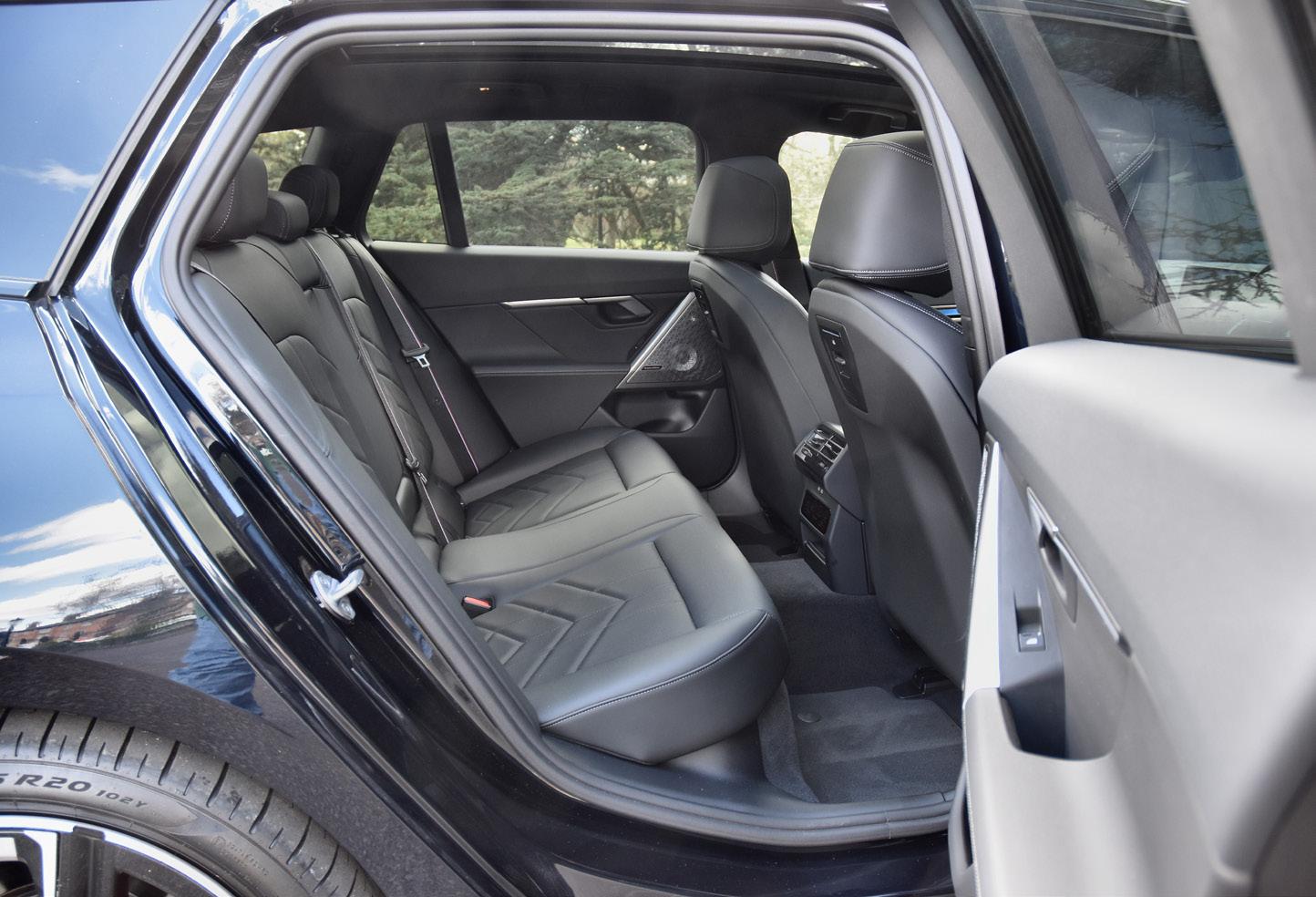



Ethos Asset Finance are the experts in your industry for finance solutions.
We’re here to make the whole process seamless.








We provide funding and sourcing packages for the chauffeur and private hire network
We have access to multiple panels of funders who also specialise in B2B vehicles finance
We make the process easy - as we do all the paperwork and sign ups
We provide ongoing support to secure credit lines for fleets and operators/owner drivers
We have access to competitive rates of interest
Efficient payouts to support delivery and target needs

Electric cars are finally starting to gain traction in the UK. The sales figures underline the growth – EV sales in the first three months of 2025 rose more than 40% year-on-year, in a market that is basically static.
And one of the main drivers of that growth is the arrival of new Chinese automakers. The electrification of the market has had a remarkable effect. Traditional loyalties are counting for less and less, and younger car buyers in particular seem excited about driving a car from a new brand.
So new brands such as BYD, Omoda and Jaecoo, with no legacy to speak of and no old petrol/diesel buyers to convert to EV, are making a storming start in the UK market. And there’s more to come. Other Chinese brands are preparing to launch here – and Skywell is one of the first to break cover.
Even in the context of the rapidly evolving Chinese sector, Skywell is something of a newcomer, having started as recently as 2017. Its parent company, Skyworth, is a consumer electronics manufacturer in China, and since 2000 it has also built buses, trucks and vans.
This car – the Skywell BE11 – is its first venture into the market. The BE11 is a compact SUV with on-trend looks –has a superficial resemblance to a number of European market rivals such as Skoda Karoq and Volkswagen Tiguan. Obvious electric competitors would be the BYD Sealion 7 and of course the Tesla Model Y.
UK sales are via an importer called Innovation Automotive, and compared to the big-money launch programmes of BYD and Omoda Jaecoo, Skywell’s arrival has been somewhat low key. No bad thing from a private hire point of view, as the


importer is specifically targeting our sector for the car, and has taken an aggressive approach to finance for the market, offering deals for less than £400 per month.
And certainly, a first look at the car reveals a vehicle that is very suitable for private hire work. It’s a surprisingly big vehicle, and that translates to a lot of interior space, especially in terms of rear cabin legroom and headroom, and a capacious 467-litre boot. Three adults fit comfortably in the back seat.
We had a first look at the BE11 last year, when the press was invited to drive early pre-production RHD models. Unfortunately for Skywell, these cars were a little glitchy, especially with regard to noisy warning bings and bongs, and this resulted in some less than positive coverage.
CONTINUED ON PAGE 28
Price as tested £39,995 OTR
Powertrain Single-motor EV
Transmission Single-speed auto, front-wheel drive
Battery pack 86kWh Li-Ion
Power 204hp
Torque 320Nm
Top speed 93mph
0-62mph 9.8sec
Electric range 304 miles (WLTP combined)
Charging time 7hr 30min AC (11kW 3-phase, 0-100%) 45min DC (80kWh rapid, 10-80%)
CO2 emissions 0g/km (WLTP)
Charge port CCS2
Length 4,720mm
Width 1,908mm
Height 1,696mm
Wheelbase 2,800mm
Loadspace 467 litres
Turning circle 11.4m
Vehicle warr'y 7 years / 100,000 miles
Battery warr'y 8 years / 155,000 miles
Service interval 12 months /15,000 miles
Insurance Gp 33
VED Band A

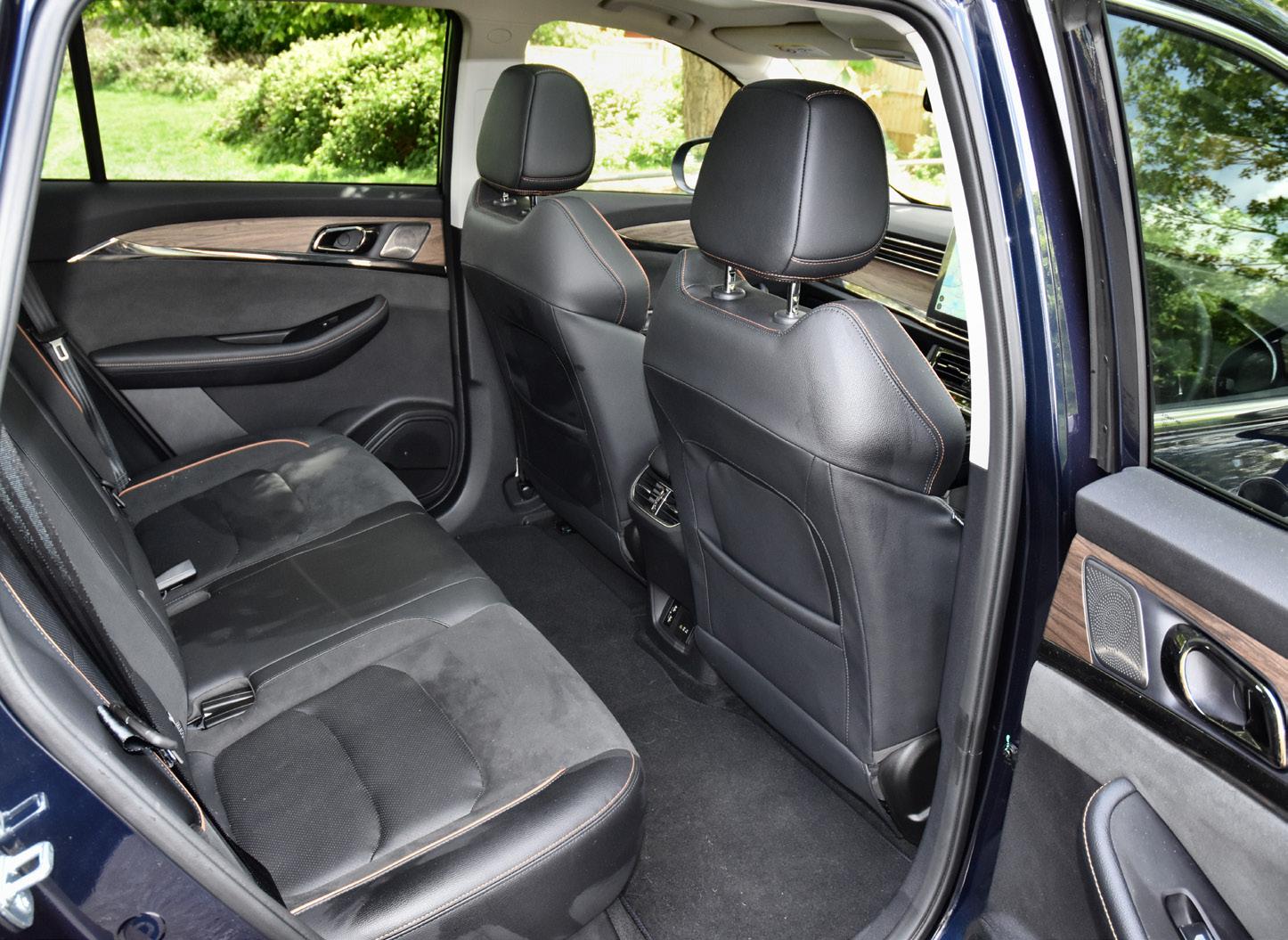

We waited for a finalised production model before passing judgement, and it’s fair to say that Skywell has addressed most of the issues. Certainly we heard very few noises at all from the car, other than some gentle EV transmission whine.
Our test car arrived fully charged with a range of 293 miles available (not far off the claimed 304 miles of WLTP range) and we carried out 282 miles of driving across all types of road – urban, motorway and cross-country – recording electricity use of 19.5kWh/100km.
The travel included one fast recharge, where we topped up from 32% to 77% (41kWh) in 33 minutes. At the end of the test, the car had an indicated range of 124 miles, so the WLTP range looks pretty accurate.
The BE11 isn’t the fastest in terms of DC charging, as it’s limited to 80kW, so recharging its 86kWh battery from 10-80% should take 45 minutes. We used an MFG 150kW rapid charger, which delivered power at a rate of 74.24kW – close to the BE11’s maximum. There are faster-charging cars, but the limit is usually the ability of the charge point to deliver at rates of 200kW and upwards. In reality, a 45-minute charge to give you around 250 miles of range should cover most private hire bases.
The driver’s seat is comfortable, and dashboard materials are decent without feeling particularly premium – soft plastics and a wood-effect finish are stylish, though, and the leather seats are very comfortable.
Like most new cars, the dashboard is dominated by a very large 12.8in touchscreen display. There’s also a 12.3in dashboard display panel. The BE11 does have its own satnav systems, but we opted to use Google Maps via Apple Car Play, which offered a better display.
The system does still have a few quirks. Brake regeneration is not simply three or four steps as on most car, but a sliding scale that can be set precisely to the nearest percent – so you can fine-tune your regen requirements. And you can retract the door mirrors independently, which could be handy in tight car parks.
Like a lot of EVs, there’s a lack of buttons (other than a few vital ones
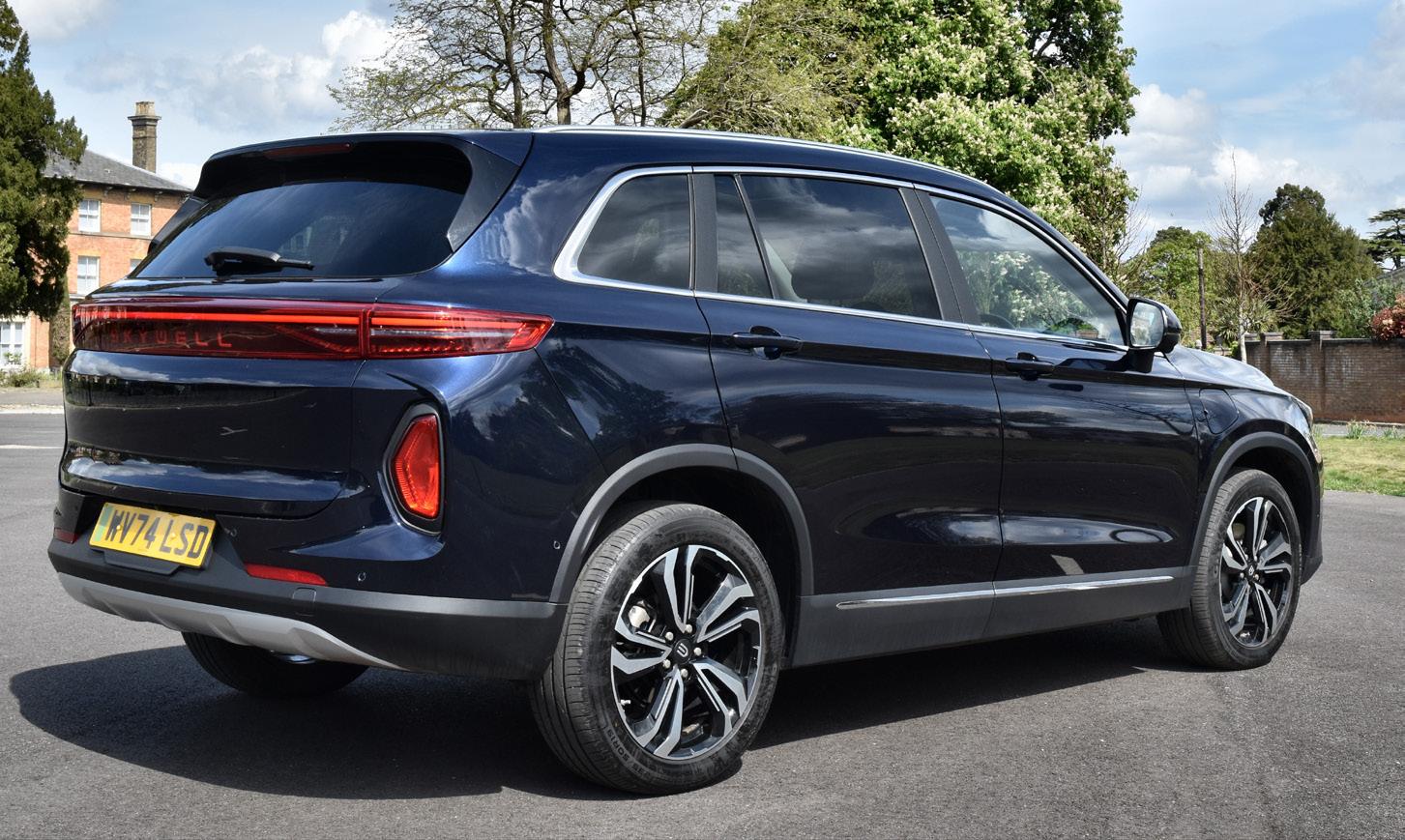
such as heated rear window). But in order to access the climate controls, you have to exit Car Play, then change the temperature, and then go back into Car Play. Not ideal, and applying some of that consumer electronic expertise to keeping the heater controls window open all the time would be a big help.
There’s an inductive phone charging pad on a shelf below the centre console, but we found this difficult to access and a little fiddly to position the phone so it started to charge. These minor glitches could do with ironing out, but they're not deal-breaking.
The BE11 is not going to tear up trees as a performance car – and it’s all the better for it. It’ll do 0-62mph in a shade under 10 seconds, but that’s more than adequate for any normal motoring.
The ride is softer than some rivals –and that’s a good thing for private hire use, where drivers will not be hooning it round bends or screaming away from traffic lights in a bid to burn off a neighbour’s Beemer.
The Skywell BE11 might not be a boy-racer’s dream, but as a practical private hire vehicle, it ticks a lot of boxes.
Available now from your local dealer, with exclusive rates for private hire vehicle operators.
The Skywell BE11 has taken a bit of stick from the consumer press on the grounds of a lack of excitement. Perhaps that’s fair criticism – but performance motoring is not what we’re looking for in the taxi and private hire market.
The BE11 is big, roomy and comfortable in the back. It offers a very usable 300-mile EV range and comes at a luxury tax-busting price of £39,995 for the version we’re testing here with the larger 86kWh battery. A 72kWh alternative has less range –248 miles – and costs £36,995.
More importantly, Skywell has a very good 4-year/30,000 miles a year lease-purchase offer which puts you behind the wheel for less than £100 a week. This includes servicing and warranty work at Halfords service centres.
The BE11 also comes with a 7-year/100,000 mile warranty, which is impressive, as well as an 8-year battery guarantee.
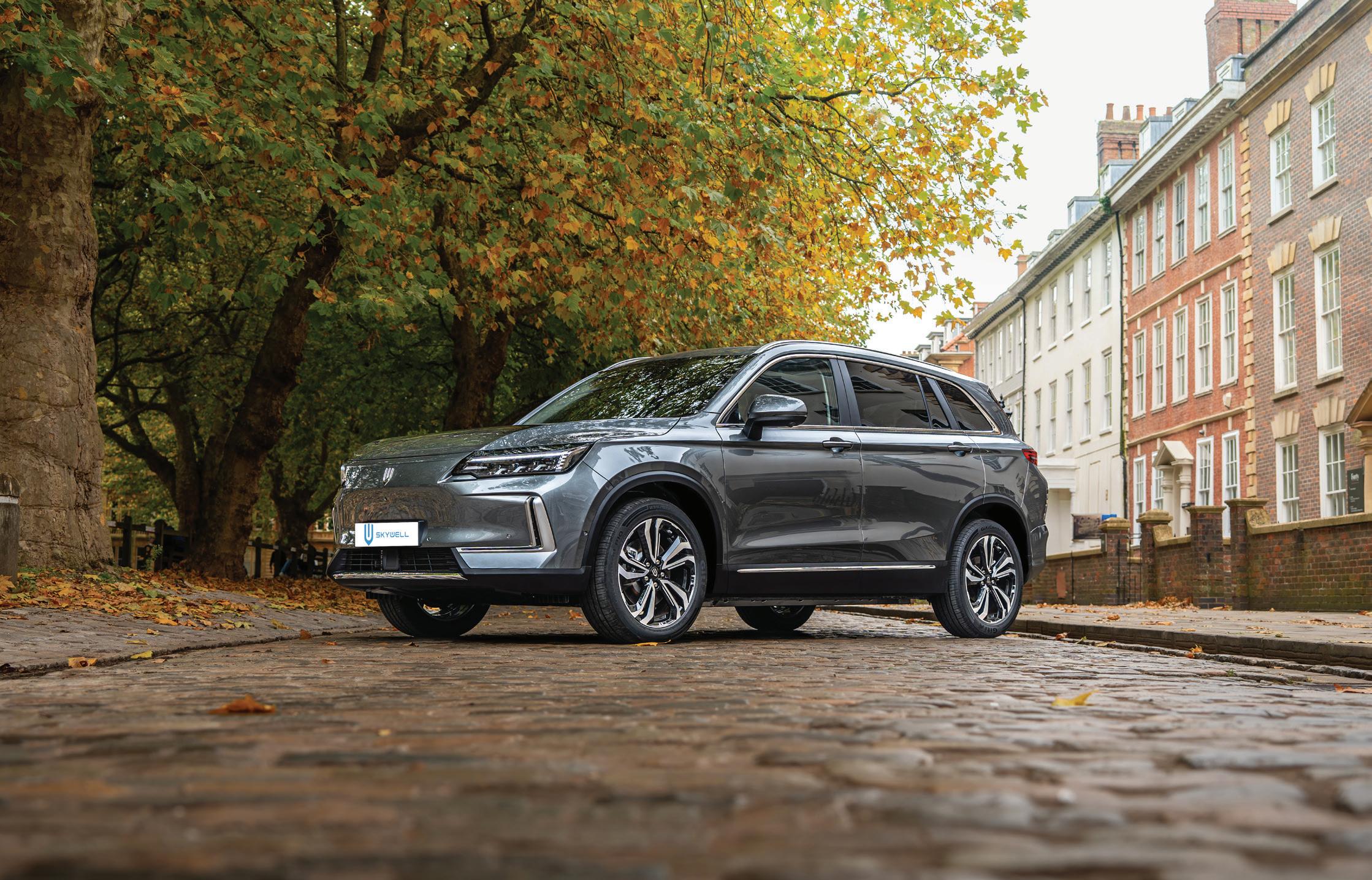
Mark Bursa Mark Bursa

Audi has been less visible in the chauffeur market over the past few years.
The aftermath of “dieselgate” has taken its toll, while the company’s electrification initiatives have been largely SUVshaped.
As a result, the 2017-vintage A8, last refreshed in 2021, is still a couple of years away from a replacement. But Audi has launched a new A6 range this year, initially as an impressive EV – which we’ll be testing in a future edition of Professional Driver – and now as a plug-in hybrid.
This puts Audi back in the game, with a serious rival to the BMW i5 and Mercedes E-Class/EQE models.
The new A6 e-hybrid quattro comes
as saloon and ‘Avant’ estate, and offers a total power output of 299PS and up to 64 miles of electric range.
The new A6 Saloon and Avant e-hybrid replace the TFSI e versions of the old A6. Both variants are available in Sport, S-line and Edition 1 trim levels.
And with prices starting at £60,980 (OTR) for the A6 Saloon in Sport trim, rising to £70,630 for the A6 Avant in Edition 1 trim, the A6 PHEV is an affordable option. UK sales begin in early June with first customer deliveries due in late Summer.
The powertrain comprises a 2.0 TFSI engine with an output of 252PS and an electric motor that delivers up to 105kW, giving a total system output of 299PS and 450Nm of torque. This equates to a 0-62mph sprint in 6.0sec.
The 25.9 kWh high-voltage battery is 45% bigger than that used in previous generations. This gives 64 miles of EV range (63 for Avant). Maximum AC charging power is now 11 kW, and a full recharge from 0-100% can take as little as 2.5 hours.
Recuperation performance has also been improved. The degree of recuperation intensity in electric driving mode (EV mode) can be adjusted to three different levels using paddles on the steering wheel.
Two operating modes are available: “EV” and “hybrid.” In EV mode, the plug-in hybrid models run solely on electric power, while in hybrid mode, the hybrid management system maintains a specific charge level as needed in order to save enough electrical
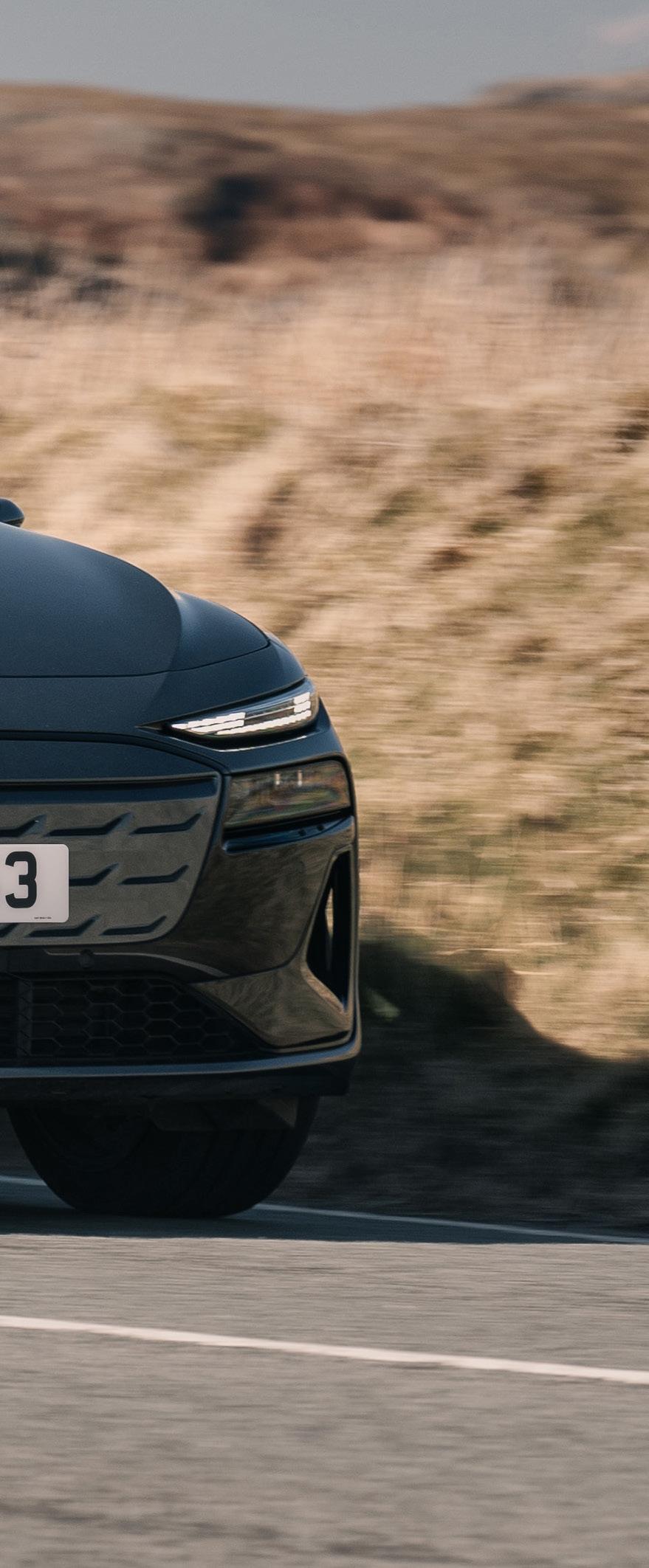
energy for later use. In addition to the automatic hybrid mode, the desired charge level can be individually selected using a digital slider.
Combined with quattro ultra drive and standard all-wheel steering, the electrified dual-clutch transmission plays a major role in the dynamic driving experience: it boosts response at low speeds and provides more stability at higher speeds.
Fitted as standard to all e-hybrid quattro variants, all-wheel steering boosts agility in city traffic and tight bends by turning the rear wheels up to five degrees in the opposite direction to the front wheels at speeds of up to 37mph. At higher speeds the rear wheels turn in the same direction, giving more precise handling.



ercedes-Benz has is looking to move the V-Class range into an even more exclusive market position, judging by a new concept car recently shown at the Shanghai Motor Show. The Vision V electric MPV concept moves the V-Class further from the van sector and into a luxury segment of its own.
The Vision V is based on a new, modular, flexible and scalable platform which Mercedes calls VAN.EA (Van Electric Architecture), and the production version of the car will be on sale next year.
Mercedes hasn’t talked about the powertrain for the production car, but it will be all-electric and it’s likely to offer a range in excess of 300 miles – a big step up on the current electric EQV.
Mercedes-Benz says the VAN.EA architecture will provide a range of vehicles, spanning practical, entry-segment family vehicles and exclusive VIP shuttles to luxurious limousines with the features of a “private lounge” – and it is this new top-line model that the Vision V provides a glimpse of.
Mercedes specifically refers to the Vision V as a “luxurious and elegant chauffeur-driven limousine”, with a traditional, crafted interior combined with high-tech features and displays. Indeed, it’s likely that there will be two versions of the next V, apparently badged VLE (standard version) and VLS (luxury model – a kind of S-Class MPV).
Vision V has a large, automatically opening clamshell door on the nearside with illuminated, retractable running boards ensuring easy access to the rear cabin. An intelligent, switchable glass wall separates the passenger area from the driver. The glass can be changed from transparent to opaque, either completely or in sections.
The seating area is exceptionally spacious. Traditionally crafted materials blend with hyper-modern, tech-savvy design elements that are both stylish and unexpected.
White Nappa leather and white silk contrast with large decorative elements made of open- pore burr wood. Similar to an exclusive sideboard, display cabinets are set into the dark wood trim along the side walls and are framed by polished aluminium trim strips.
The centre console between the two individual seats is also designed as a display cabinet. It has a touchpad for operating the infotainment system as well as a fold-out table. When extended, the table appears as a high-quality chess board. The centre console automatically adjusts to the respective seating position for maximum comfort.
The electrically adjustable second-row seats rest on polished aluminium bases. They can be reclined into a flat position. All-round ambient lighting with strip lighting and a ceiling lamp create an living-room atmosphere.
A retractable, 65in 4K resolution cinema screen – with split-screen functions – is located under the floor. As soon as the passengers are inside and the doors are closed, it glides up and separates the “rear cabin from the cockpit.
The Vision V’s dashboard also uses the Mercedes ‘Superscreen’ with three integrated screens stretching from pillar to pillar. Real-time graphics provide all essential information and displays the vehicle’s surroundings on the map in real time and in conjunction with the assistance systems.





City Hall in London has recently published its Taxi and Private Hire Action Plan. It is, with no cynicism implied or meant, a list of good intentions encompassing the usual suspects.
These include safety, training, accessibility, environment together with some innovation around toilet facilities, performance recognition, and then some problem-solving. How to recruit more taxi drivers, reduced VAT on electric vehicles and charging and, of course, cross-border hiring.
While studying the action plan, the point that struck me was that ‘plans’ published by regulators and policy makers are almost always about inputs. London is not alone here. But why do we not measure outcomes?
There is almost a culture these days of virtue-signalling – we have a problem (perceived or real), lets consult and engage, let’s put some training in place, lets pat ourselves on the back and move on. The notion that the ‘problem’ pertains doesn’t seem to feature in the programme at all. But isn’t it really back to the old maxim that ‘it is not what you do, its what you achieve that matters’?
This industry has endured, I choose my words carefully, a torrent of new regulations, guidance and best practice over recent years with the imposers being able to point to the things they have done. But who is pointing at the outcomes? Have they worked? Whatever the problem was, is it now resolved, smaller, the same, more serious? Who knows and who cares. We did our bit we beefed up the regulations, the requirements, the obligations or insisted on a new sticker. Which body is responsible for holding the imposers to account?
I would urge representative organisations, operators, drivers and policy makers to question what the baseline is (what is the position now) and the measurements that will be put in place for any new obligations and requirements. Let’s have a publicly available

Dr Michael Galvin
quarterly update on what has been achieved.
Therefore, if we take an example –every driver to be trained in disability awareness – what are the outcomes? A balanced scorecard approach would work. Are there fewer complaints from disabled people? Are disabled people travelling more? Do disabled people rate the service more highly? Is the trajectory positive? If we are not doing this what is the point?
Drivers are expected to take time off work to undertake courses. Someone is paying for it and if disabled people feel that the service is the same or worse – what has been achieved, apart from another line on the regulator’s Environmental, Social, Governance (ESG) list?
Being more positive let’s just say that if a new obligation has been imposed on the industry and the outcomes are wonderful, surely that is a great thing? Let’s use the earlier example and assume that following the disability awareness training, all surveys, feedback from users and user groups and complaint levels are all positively changed. Wouldn’t that be something to celebrate? Might it lead to deeper insights to improve that aspect of the service even more?
Plastering vehicles in stickers until they look like ice cream vans may be an obsession for some regulators, but what are the outcomes? Do passengers raise their complaints with the regulator more often? Do the public understand or care what ‘pre-book only’ means if they are cold, wet, slightly inebriated and just want to get home? How many fires have been put out by taxi drivers in areas where they are told to carry a fire extinguisher? Shouldn’t they just dial 999?
We are in a digital age where customer information can be sent to a passenger’s mobile phone where
it can sit for eternity so why plaster more stickers on cars? But if that is what regulators believe is needed then put the measurements in place to validate those beliefs and roll out yet more stickers.
I, and I think most people, want the taxi and private hire industry to grow and prosper and one of the strategies to growth and prosperity is to demonstrate safety, good customer service, being accessible - and be environmentally friendly.
Just imposing regulations that may or may or may not work, training that may be great or pointless and developing yet another sticker is not the way to achieve that strategy.
You get what you measure
Oh, but Mike, I hear regulators and policy makers say, you can’t measure everything. Really? Let’s take safeguarding. If a regulator makes a safeguarding course mandatory from an ESG perspective – job done! We can now defend any incident if pounced on by the press.
Yes, that’s probably true - but how about actually improving safeguarding as that was the problem that the training set out to solve. Has anything changed? Possibly not. No one will know unless the outputs are measured. Are there more reports of safeguarding concerns being received by the police in that area? No? Are there fewer complaints about driver behaviour? No? Well in that case the training probably needs to be revisited. You get what you measure, and if it can’t be measured you probably shouldn’t be doing it!
This industry is incurring growing costs through the imposition of measures fundamentally developed to improve safety, reduce environmental impact, enhance accessibility, highlight safeguarding and boost customer service and our vehicles are being defaced through more and more stickers. Isn’t it about time that the imposers started to take responsibility for establishing the baseline and then measuring outcomes and making them publicly available?
We all complain about our jobs, it’s cathartic. Who needs all that mindfulness and awareness stuff that people peddle at vast expense? For me, there is nothing better than getting the stresses of the day off your chest with a proper, good, old-fashioned moan.
Most days we enjoy what we do, some days not so much, and that is just life. But before the next time I start to complain (in the confines of my own head) about the traffic, road closures and colour-blind cyclists, I fully intend to take a deep breath and thank God I didn’t become a plumber!
Some of you may remember that I sold my house during Covid. I tell people I wanted to give myself flexibility in an uncertain world when actually I was just bricking it that they’d repossess me before any more work came in.Last January saw our five-year nomadic existence come to an end when we bought a new house.
One of the first challenges in our new gaff is to change the avocado bathtub. Old one out, a new one back in. What could be simpler?
The first plumber cancelled on us twice, his first excuse was down to Mounjaro, the weight loss jab that he had just taken and had made him too ill to function. Ok, I sort of understand that, until the second excuse given for his next failure to show was simply that he “wasn’t feeling it today”.
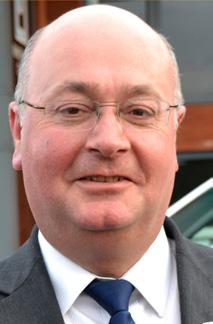
Kevin Willis Chirton Grange contact@chirtongrange.co.uk
confirmed this was exactly the job in hand he looked at me, shook his head, and said: “Yeah, you’re better to leave the old one in and save yourself the trouble and expense.”
Now, I am no great salesperson but for sure I didn’t have to be the Wolf of Wall Street to know never to ask a client if their journey was really necessary. This approach, I believe, would be counter-productive to me paying down the vast new mortgage I’ve just hung around my neck.
Changing the tap and fitting a new waste was also, it seemed, going to be a major problem. At one point he even talked about removing the toilet just to be able to fit the bath panel.In my heart I knew Colin wasn’t the guy for us, which was confirmed when I asked him if he would like a coffee to enjoy while he sat inventing problems that didn’t exist. His response was to look at me like I’d just ‘goosed’ his missus and reply: “Nah, cos then I’d need the loo!” Finding a habitable toilet in our line of work is an age old problem but when you literally work in the very room that houses the apparatus to complete the matter at hand, why was he so worried?

So we try another plumber. Colin turned out to be the most negative person I have ever met in my life, and I have met many Sunderland FC fans! He had already started sucking his teeth before I answered the door to him, whereupon he proceeded to huff and puff so much I worried he might blow my house down.
“So you want that bath to come out and a new one to go in?” When I
My hope is that Colin had a strategy, a technique whereby he listed all the pitfalls and problems in the hope of scaring me into accepting his inordinately large quotation safe in my new-found knowledge that this was not going to be a straight forward job.
We could adopt this approach. “Of course I can pick you and your family up and take you to the airport. The only thing is you are going to have luggage, and there might be too much luggage. I guess we won’t know until the day. Shouldn’t be a problem, I’m just saying you might have to leave
one of your kids home alone but that is a worst-case-scenario.”
“Also, how big are the suitcases? Just to know whether I need to bring Big Dave down to help give me a lift. Shouldn’t be a problem, Are we using your car seats or am I having to nip to Halfords and purchase the very items I should already have for the job I do? We’ll use your car seats but you’ll need to fit them into my car on the day as I cannot be held responsible for being a lazy tosser. And don’t forget, that I’ll need to add storage costs for me looking after the seats while you are on holiday.”
“For sure we will hit traffic on the way so you might want to reconsider your plans and drag your voluminous luggage onto buses, trains, and tube because they don’t get stuck in traffic. On the other hand why not save yourself, and the environment, a whole packet of grief by just staying at home and not travelling at all.”
“A cup of tea never tastes the same when you are abroad. Also the world might end in a huge fireball by next Thursday. I am talking about a worstcase scenario.”
The approach from these plumbers to customer service was staggering and amazes me how people who profess to operate in a service industry can adopt an attitude that makes them have more negatives than Snappy Snaps did in 1984.
If I can be so bold as to teach anything to you of my thirty years’ experience in the business it is this: Always smile until they give you reason not to. And provide service without being subservient and always be positive unless having a test for Covid or an STD.
As we prepare to enter the silly, busy summer period, we need to brace, brace and embrace the madness that is about to befall us, appreciating the fact you aren’t a plumber removing a toilet to fit a bath panel.
With a new found optimism for your good fortune I hope this spurs you on to enjoy most of your days out on the road resulting in you fewer complaints from your clients – and from you!
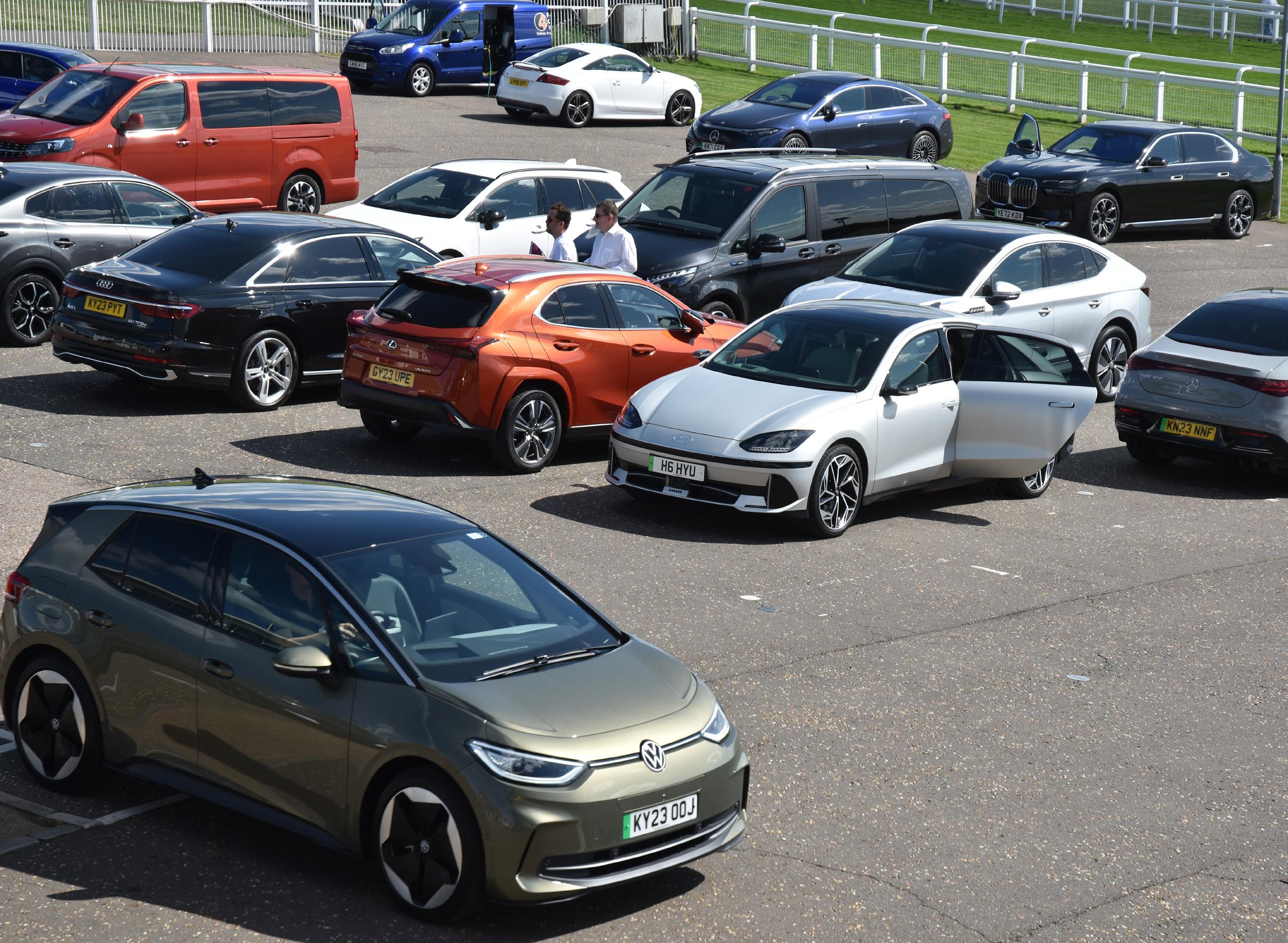
Tuesday, August 19, 2025, Epsom Racecourse
Tuesday, August 19, 2025, Epsom Racecourse


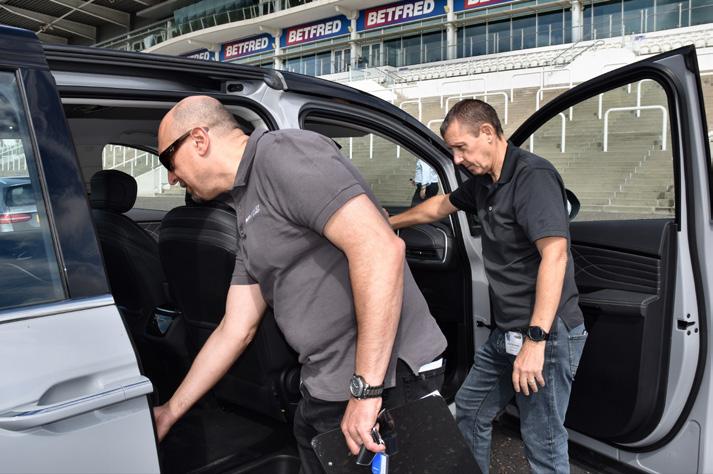
We’ll be judging next year’s Cars of the Year - yes, the 2026 winners - on Tuesday, August 19, 2025, at our regular venue, Epsom Racecourse in Surrey. It’s a fun day where you will have the chance to drive up to 50 of the latest cars suitablefor private hire and chauffeur work.
We’d love it if you could join us for the day and help us choose our winners. Put the date in your diary and let us know by emailing editor@prodrivermags.com and we’ll be in touch. See you there!
In association with


